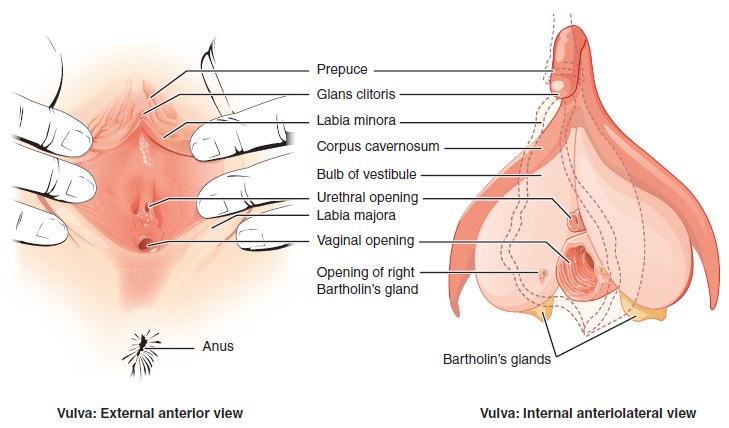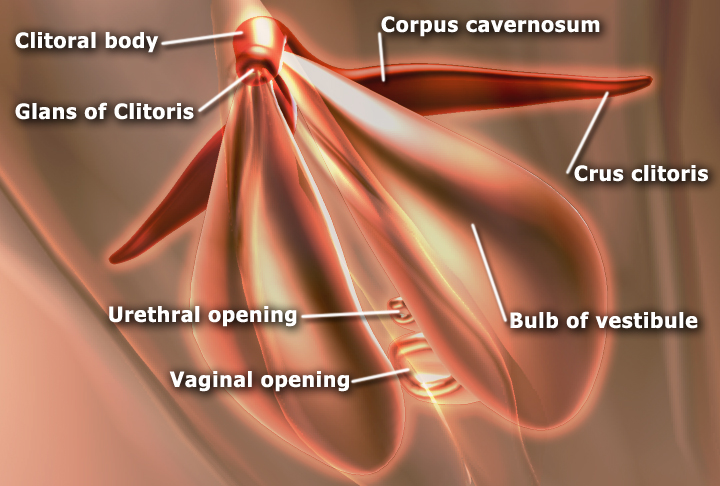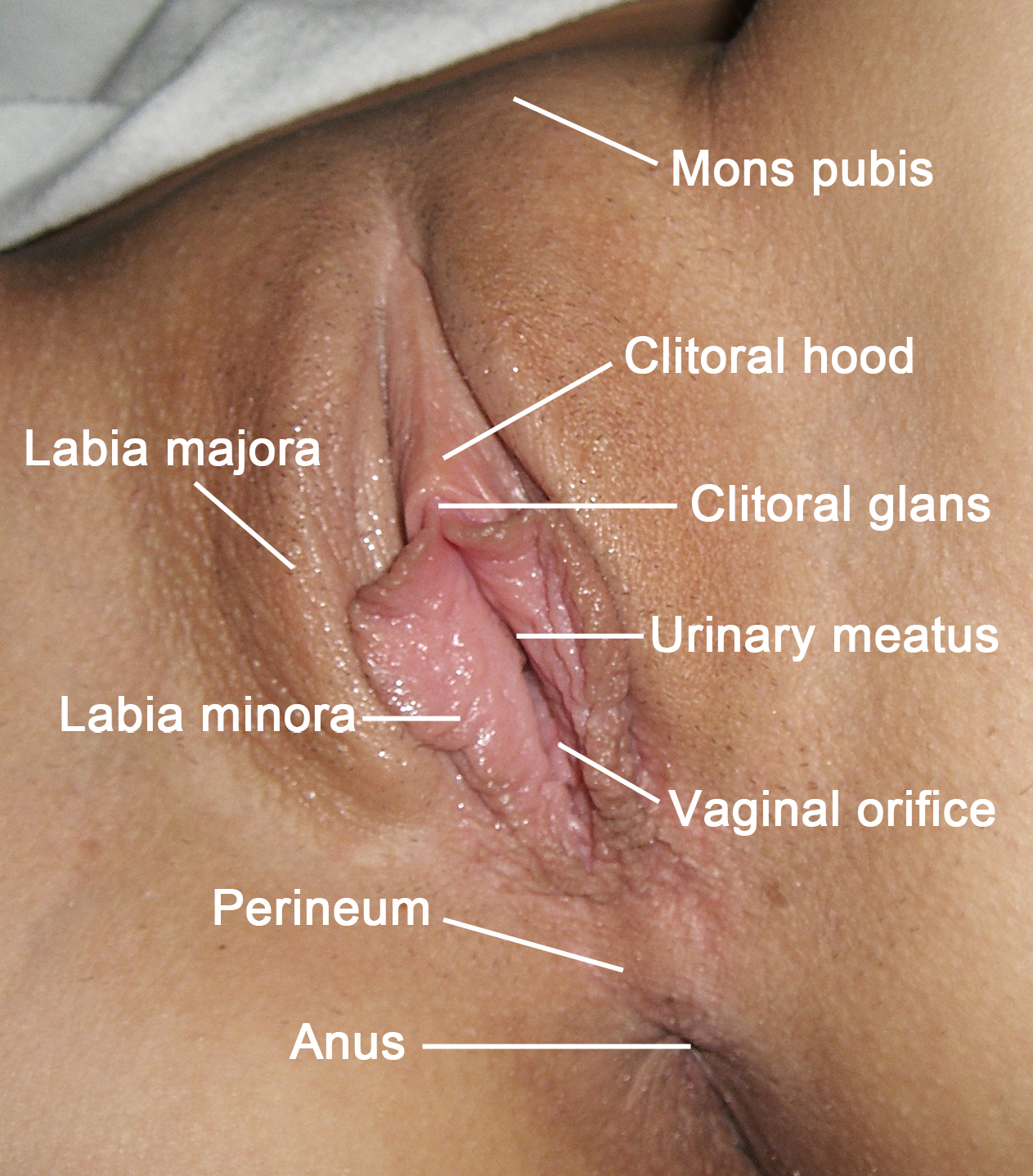|
Clitoris
The clitoris ( or ) is a female sex organ present in mammals, ostriches and a limited number of other animals. In humans, the visible portion – the glans – is at the front junction of the labia minora (inner lips), above the opening of the urethra. Unlike the penis, the male homologue (equivalent) to the clitoris, it usually does not contain the distal portion (or opening) of the urethra and is therefore not used for urination. In most species, the clitoris lacks any reproductive function. While few animals urinate through the clitoris or use it reproductively, the spotted hyena, which has an especially large clitoris, urinates, mates, and gives birth via the organ. Some other mammals, such as lemurs and spider monkeys, also have a large clitoris. The clitoris is the human female's most sensitive erogenous zone and generally the primary anatomical source of human female sexual pleasure. In humans and other mammals, it develops from an outgrowth in the em ... [...More Info...] [...Related Items...] OR: [Wikipedia] [Google] [Baidu] |
Vulva
The vulva (plural: vulvas or vulvae; derived from Latin for wrapper or covering) consists of the external female sex organs. The vulva includes the mons pubis (or mons veneris), labia majora, labia minora, clitoris, vestibular bulbs, vulval vestibule, urinary meatus, the vaginal opening, hymen, and Bartholin's and Skene's vestibular glands. The urinary meatus is also included as it opens into the vulval vestibule. Other features of the vulva include the pudendal cleft, sebaceous glands, the urogenital triangle (anterior part of the perineum), and pubic hair. The vulva includes the entrance to the vagina, which leads to the uterus, and provides a double layer of protection for this by the folds of the outer and inner labia. Pelvic floor muscles support the structures of the vulva. Other muscles of the urogenital triangle also give support. Blood supply to the vulva comes from the three pudendal arteries. The internal pudendal veins give drainage. Afferent l ... [...More Info...] [...Related Items...] OR: [Wikipedia] [Google] [Baidu] |
Dorsal Nerve Of Clitoris
The dorsal nerve of the clitoris is a nerve in females that branches off the pudendal nerve to innervate the clitoris. The nerve is important for female sexual pleasure, and it may play a role in clitoral erections. It travels from below the inferior pubic ramus to the suspensory ligament of the clitoris. At its thickest, the DNC is in diameter, visible to the naked eye during dissection. The DNC splits into two nerve branches on either side of the midline, closely following the crura of the clitoris. Some surgeries—for example, sling surgeries to treat female urinary incontinence—can damage the DNC, causing a loss of sensation in the clitoris. Understanding the nerve is important for urologists and gynecologists who may operate on organs near the DNC. The dorsal nerve of the clitoris is analogous to the dorsal nerve of the penis in males. It is a terminal branch of the pudendal nerve. See also * Posterior labial nerves * Perineal nerve The perineal nerve is a nerve o ... [...More Info...] [...Related Items...] OR: [Wikipedia] [Google] [Baidu] |
Clitoral Hood
In the female human body, the clitoral hood (also called preputium clitoridis and clitoral prepuce) is a fold of skin that surrounds and protects the glans of the clitoris; it also covers the external shaft of the clitoris, develops as part of the labia minora and is homologous with the foreskin (also called the ''prepuce'') in the male reproductive system. The clitoral hood is composed of muccocutaneous tissues; these tissues are between the mucous membrane and the skin, and they may have immunological importance because they may be a point of entry of mucosal vaccines. The clitoral hood is also important not only in the protection of the clitoral glans, but also in pleasure, as its tissue forms part of the erogenous zones of the vulva. Development and variation The clitoral hood is formed during the fetal stage by the cellular lamella. The cellular lamella grows down on the dorsal side of the clitoris and is eventually fused with the clitoris. The clitoral hood is formed f ... [...More Info...] [...Related Items...] OR: [Wikipedia] [Google] [Baidu] |
Human Sexuality
Human sexuality is the way people experience and express themselves sexually. This involves biological, psychological, physical, erotic, emotional, social, or spiritual feelings and behaviors. Because it is a broad term, which has varied with historical contexts over time, it lacks a precise definition. The biological and physical aspects of sexuality largely concern the human reproductive functions, including the human sexual response cycle. Someone's sexual orientation is their pattern of sexual interest in the opposite or same sex. Physical and emotional aspects of sexuality include bonds between individuals that are expressed through profound feelings or physical manifestations of love, trust, and care. Social aspects deal with the effects of human society on one's sexuality, while spirituality concerns an individual's spiritual connection with others. Sexuality also affects and is affected by cultural, political, legal, philosophical, moral, ethical, and religious ... [...More Info...] [...Related Items...] OR: [Wikipedia] [Google] [Baidu] |
Labia Minora
The labia minora (Latin for 'smaller lips', singular: ''labium minus'', 'smaller lip'), also known as the inner labia, inner lips, vaginal lips or nymphae are two flaps of skin on either side of the human vaginal opening in the vulva, situated between the labia majora (Latin for 'larger lips'; also called outer labia, or outer lips). The labia minora vary widely in size, color and shape from individual to individual. The labia minora are homologous to the male urethral surface of the penis. Structure and functioning The labia minora extend from the clitoris obliquely downward, laterally, and backward on either side of the vulval vestibule, ending between the bottom of the vulval vestibule and the labia majora. The posterior ends (bottom) of the labia minora are usually joined across the middle line by a flap of skin, named the frenulum of labia minora or fourchette. On the front, each lip forks dividing into two portions surrounding the clitoris. The upper part of each lip p ... [...More Info...] [...Related Items...] OR: [Wikipedia] [Google] [Baidu] |
Spotted Hyena
The spotted hyena (''Crocuta crocuta''), also known as the laughing hyena, is a hyena species, currently classed as the sole extant member of the genus '' Crocuta'', native to sub-Saharan Africa. It is listed as being of least concern by the IUCN on account of its widespread range and large numbers estimated between 27,000 and 47,000 individuals. The species is, however, experiencing declines outside of protected areas due to habitat loss and poaching. The species may have originated in Asia, and once ranged throughout Europe for at least one million years until the end of the Late Pleistocene. The spotted hyena is the largest known member of the Hyaenidae, and is further physically distinguished from other species by its vaguely bear-like build, its rounded ears, its less prominent mane, its spotted pelt, its more dual-purposed dentition, its fewer nipples and the presence of a pseudo-penis in the female. It is the only placental mammalian species where females lack an ext ... [...More Info...] [...Related Items...] OR: [Wikipedia] [Google] [Baidu] |
Erogenous Zone
An erogenous zone (from Greek , ''érōs'' "love"; and English ''-genous'' "producing", from Greek , ''-genḗs'' "born") is an area of the human body that has heightened sensitivity, the stimulation of which may generate a sexual response, such as relaxation, sexual fantasies, sexual arousal and orgasm. Erogenous zones are located all over the human body, but the sensitivity of each varies, and depends on concentrations of nerve endings that can provide pleasurable sensations when stimulated. The touching of another person's erogenous zone is regarded as an act of physical intimacy. Whether a person finds stimulation in these areas to be pleasurable or objectionable depends on a range of factors, including their level of arousal, the circumstances in which it takes place, the cultural context, the nature of the relationship between the partners, and the partners' personal histories. Erogenous zones may be classified by the type of sexual response that they generate. Many peo ... [...More Info...] [...Related Items...] OR: [Wikipedia] [Google] [Baidu] |
Dorsal Artery Of Clitoris
The internal pudendal artery is one of the three pudendal arteries. It branches off the internal iliac artery, and provides blood to the external genitalia. Structure The internal pudendal artery is the terminal branch of the anterior trunk of the internal iliac artery. It is smaller in the female than in the male. Path It arises from the anterior division of internal iliac artery. It runs on the lateral pelvic wall. It exits the pelvic cavity through the greater sciatic foramen, inferior to the piriformis muscle, to enter the gluteal region. It then curves around the sacrospinous ligament to enter the perineum through the lesser sciatic foramen. It travels through the pudendal canal with the internal pudendal veins and the pudendal nerve. Branches The internal pudendal artery gives off the following branches: The deep artery of clitoris is a branch of the internal pudendal artery and supplies the clitoral crura. Another branch of the internal pudendal artery is the dorsa ... [...More Info...] [...Related Items...] OR: [Wikipedia] [Google] [Baidu] |
Development Of The Reproductive System
The development of the reproductive system is the part of embryonic growth that results in the sex organs and contributes to sexual differentiation. Due to its large overlap with development of the urinary system, the two systems are typically described together as the urogenital or genitourinary system. The reproductive organs develop from the intermediate mesoderm and are preceded by more primitive structures that are superseded before birth. These embryonic structures are the mesonephric ducts (also known as ''Wolffian ducts'') and the paramesonephric ducts, (also known as ''Müllerian ducts''). The mesonephric duct gives rise to the male seminal vesicles, epididymes and vas deferens. The paramesonephric duct gives rise to the female fallopian tubes, uterus, cervix, and upper part of the vagina. Mesonephric ducts The mesonephric duct originates from a part of the pronephric duct. Origin In the outer part of the intermediate mesoderm, immediately under the ectoderm, in t ... [...More Info...] [...Related Items...] OR: [Wikipedia] [Google] [Baidu] |
Superficial Dorsal Veins Of Clitoris
The superficial dorsal veins of clitoris is a tributary of the external pudendal vein The external pudendal veins (deep pudendal & superficial pudendal) are veins of the pelvis which drain into the great saphenous vein. Additional Images File:Slide2Thai.JPG, Anterior abdominal wall. Superficial dissection. Anterior view. File:Slid .... External links * https://web.archive.org/web/20071024000415/http://anatomy.med.umich.edu/anatomytables/veins_pelvis_perineum.html Veins of the lower limb Clitoris {{circulatory-stub ... [...More Info...] [...Related Items...] OR: [Wikipedia] [Google] [Baidu] |
.png)





